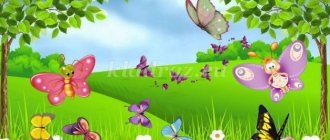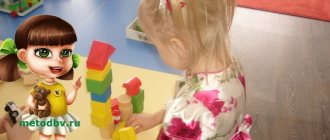Summary of the book
The content of this methodology meets all the requirements of the Federal State Educational Standard and includes the following sections:
- studying the properties of objects and numbers;
- patterns;
- numbers;
- quantities;
- spatiotemporal representations.
Children in kindergarten
At a younger age, they study only numbers, and at an older age they study simple arithmetic operations with them. All classes should be conducted taking into account the child’s leading activity in the preschool period - play. But lessons should be conducted regularly so that the knowledge gained is systematized.
For children 4-5 years old
This part of the manual is not aimed at memorizing and memorizing, but at developing in children the ability to independently draw conclusions, reason and prove their point of view. There is no need to force him to study mathematics; teachers should try to motivate him.
Important! The book should not be given in full at once: you need to cut off the pages as you complete tasks and put them in a separate folder. And at the end of the school year it can be given to the student’s parents.
This tutorial covers the following topics:
- "Repetition";
- "Earlier, later";
- “Height comparison”;
- "Number and figure 4";
- "Square";
- "Cube";
- "Up, Down";
- “Width comparison”;
- "Number and figure 5";
- "Oval";
- "Inside Outside";
- “In front, behind, between”;
- "Pair";
- "Rectangle";
- "Number series";
- “Ri;
- "Ordinal counting";
- "Comparison by length";
- "Number and figure 7";
- “Numbers and figures 1-7”;
- "Comparison by thickness";
- "Higher lower";
- "Plan";
- "Number and figure 8";
- "Cylinder";
- "Cone";
- "Prism and Pyramid".
Important! After studying all the topics, the second part of “The Game” contains tasks for repeating all the material.
Each section offers several exercises for practicing and consolidating:
- comparison;
- complete the figures;
- connect the dots;
- find an extra item and explain why;
- paint over the required number or suitable figure;
- passing the labyrinth;
- drawing up proposals.
Exercises have a positive effect on the development of fine motor skills and speech development. All topics are illustrated, because when working with preschoolers you need to use visual material. It is important that the teacher does not give children ready-made answers, but helps them find the answer to the questions on their own. At the age of 4-5 years, teachers develop an interest in studying mathematics.
Boy doing math
For the average group 5-6 years old
In Peterson's book, Mathematics for Preschoolers, middle grades begin introducing children to simple arithmetic and expanding upon their existing knowledge. In this manual for the middle group, the following sections are studied in detail:
- properties of objects;
- comparison;
- addition;
- work on spatial representations of ON, OVER, UNDER;
- work on the concepts of “right”, “left”;
- subtraction;
- work on the concepts of “between”, “in the middle”, “inside”, “outside”;
- one-many;
- study of figures and numbers.
How and when to instill a love of reading in children, ways to interest them
In the middle group, more time is allocated to the study of each topic, because these are the first steps for children to go to school.
Important! Classes should not be too long. It is necessary to arrange physical minutes and a change of activity.
Preschoolers are offered to perform the following types of exercises:
- search for identical features and differences;
- search for similar shapes and paint over them;
- searching for extra items;
- working with tables.
The child must give a detailed answer to almost every exercise. Thus, the development of coherent speech and grammatical structure occurs. Several lessons are allocated for the study of each topic, because the material becomes more complex. Therefore, the use of Peterson's mathematics manual for children 5-6 years old allows for an integrated approach to learning.
For preschoolers 6-7 years old
In the preparatory group, most of the classes are devoted to practicing arithmetic operations. New topics include the following:
- area measurement;
- length measurement;
- mass measurement;
- watch.
Didactic games
Peterson’s book “Preparing for School for 6-7 Years” offers handouts so that preschoolers can apply knowledge in practice and better master the knowledge they have acquired.
The advantage of this technique is that it is not a mathematics textbook for kindergarten, but a workbook. And you can study with notebooks “One is a step, two is a step...” at home. The tasks are appropriate for the child’s age and become more difficult gradually. It is advisable to conduct lessons in a playful way so that children do not lose interest in learning a new subject for them.
How are classes taught in the Peterson program?
Children are not given clear definitions. They are given the opportunity to “feel” these concepts, to choose, if you like, “their own” definitions. A striking example is the multiplication table. Peterson's teachings say that children do not have to be taught the multiplication tables. You can allow them to use notes. And they will remember it themselves, in the process of solving interesting problems.
As Lyudmila Georgievna herself notes, the program is suitable for children of absolutely all levels. Many people are not good at mathematics because they don’t understand it: they don’t understand the meaning of what they are doing. Solving interesting problems will captivate kids and explain things that are unclear even to those children who, at first glance, are lagging behind in development. That is why Peterson’s mathematics is subsequently used in correctional classes.
Peterson gives clear recommendations not to interfere with a child's learning about mathematics. What do parents usually do? They suggest the answer. Peterson School Prep does not accept this. The standard of the program is designed in such a way that every child, a future elementary school student, can independently complete the task without the help of an adult. A parent can only push the child to the right decision: “What is known? What do you need to find?
Author: Maria Danilenko.
Peterson preschool education: how to conduct classes
The learning process in this manual should be built taking into account the following methodological principles:
- Creating a favorable psychological environment is one of the main principles in training. A comfortable environment has a beneficial effect on the general condition of the child.
- Activity approach - a preschooler learns about the world not by receiving ready-made answers, but as a result of independent search. An adult is more of an observer.
- Individual approach - the teacher creates situations in which each child in the group feels like part of the team.
- Integrity - the learning process is not limited to kindergarten. One of the teacher’s tasks is to convey to parents the importance of continuing the educational process during other activities.
- Variability - the use of tasks with multiple answer options.
- Creative approach - here it is important not only to encourage the child’s creative activity, but also to work together with adults.
- Continuity.
Important! Group classes according to Peterson using situational technology, which helps make the educational process interesting for children.
Different creative drawing techniques with children
There are 3 types of situations in the lesson:
- “discovery” of new knowledge;
- training;
- final.
A feature of the first type of classes is the implementation of educational goals with the study of new mathematical topics. Children are given the opportunity to reason and find the answer on their own. At the beginning of classes, the teacher introduces a new topic and talks about its significance. Next, he creates a difficult situation, which results in the “discovery” of new knowledge.
To do this, the teacher invites the student to perform an action using new knowledge. Thanks to this, the adult brings the preschooler to the realization that he is not yet ready to perform new skills. Solving practical exercises on a new topic and consolidating it. In this lesson, the main goal of the teacher in this type of lesson is to involve the child in the educational process.
Didactic material
The teacher, by asking leading questions, encourages the child to choose a way to solve a difficult situation. As a result of the successful application of new knowledge in practice, it is imperative to praise the child. At the end, the teacher pronounces the solution algorithm without going beyond the game method.
He then creates different situations to use the new skill. Or organize a small self-test. When summing up the results, the teacher talks about the conditions due to which the result was achieved.
A training type lesson can be carried out in a playful way. The purpose of such lessons is to consolidate the acquired knowledge. But it does not take place in the form of standard memorization. The child independently finds difficulties that prevent him from mastering a new topic and coping with them. When summing up the results, the teacher should pay attention to what helped him emerge victorious.
Important! Final classes are conducted with the participation of two teachers. One of them organizes the educational process, and the second records the results obtained. The purpose of such lessons is to systematize the acquired knowledge and check how much the child has learned it.
MAGAZINE Preschooler.RF
The technique of Lyudmila Georgievna Peterson is known all over the world. It allows you to study the most difficult things in the most accessible forms: play, communication, etc. The main thing is that the children have fun and interesting!The principle of layer pie in the Peterson method The Peterson method is based on the “layer pie” method. Knowledge is taught in a simple accessible form. The child, as it were, “layers” new information on existing knowledge. Peterson's technique gives each child a chance to put aside material that is too difficult for him for a while, and then master it at a new stage of development. In addition, the Pereson method takes into account that the child quickly learns the knowledge that he needs. The method provides for motivation - the child himself must want to learn to count! Peterson's technique is close to the real needs of the child. This is probably why children studying using the Peterson method know much more than their peers and are 1–2 years ahead of them in development.
Methods for studying mathematics according to Peterson Mathematics develops logical thinking, teaches you to analyze and predict events. For the development of the child, groups are created to study logic. And it’s easiest for children to learn everything when they play. After all, a game is the first building block of knowledge, based on which children begin to invent new game options themselves, developing their logical abilities. Mathematics and logic are two integral parts of a child’s analytical abilities. In many specialized schools, mathematics is taught using the Peterson method. If in the standard study of mathematics we studied addition and subtraction in the first grade, and then multiplication and division, then Peterson’s method involves learning everything at once! There is only one thing - first the simplest, then the information is added in a more complex form. This allows the child to remember and at the same time repeat all the basics of mathematics, as well as develop, develop and develop. The main thing is that thanks to playful forms of presenting mathematical knowledge, the child’s fear of new things disappears. The child knows that he can do anything!
Peterson Method – from the age of three! Teaching children using the Peterson method can begin at the age of three (or even earlier!). Only at three, four, and five years old should a child receive the same knowledge with a gradual increase in information. Peterson’s method stipulates that if a child missed something at age three, he will definitely learn it at age five.
Peterson Methodology – patterns develop logic If you are planning to study with your child using the Peterson Methodology, you must take into account that this method (like mathematics itself!) is based on patterns. The child should be able to build a pattern of 3 yellow cubes and 1 red. At five years old, he will be faced with a more difficult task: to form a pattern of 2 blue, 2 green and 2 red.
Number trickle in the Peterson method Children who study according to the Peterson method always have a large number trickle before their eyes. When he needs to add 3 to 1, he puts his finger on the number 1 and takes three steps forward. If you need to subtract 2 from 5, then the baby puts his finger on the number five and takes two steps back. That's all the game logic! But mathematics is very easy for children!
The main slogan of the Peterson method: Why teach children difficult if it can be easy!? Color rhythms in the Peterson method Place cubes on the floor: 2 red, 2 green, 2 red and 2 green... Ask to continue this line. If a child, for example, puts down a yellow cube, explain to him that the color sequence is broken.
Differences according to the Peterson method When the child knows that an object can be large or small, red or green, a ball or a cube, play with him in differences. Invite him, following the big blue ball, to draw some object that will differ from it in only one way. The child can draw a small red ball or a large green ball or a red cube. This is his fantasy, the main thing is that logic works for him - the basis of mathematics!
Inequalities using the Peterson method You can teach your child to solve inequalities. Place 5 apples on one plate and 3 on the other and ask the child where there are more apples. If he finds it difficult to answer this question, place an apple from each plate, and then explain to him that there were more apples in the plate with the remaining 2 apples. Children usually love this task very much. Play math with your children, and perhaps your child will find it very easy and interesting to study at school. Below are several games based on the Peterson method aimed at creating an interesting and meaningful system of knowledge from the standpoint of general ideas about the world around us, aimed at the comprehensive development of the child, his intellectual abilities and positive personality traits. Paths The first step in preparing a child’s hand to master writing can be exercises called “Tracks”. When performing these exercises, precision of movement develops. You draw paths of different shapes, at the beginning of each path you draw, for example, a car, and at the end - a house.
Then tell the child: “You are a driver, and you need to drive your car to the house.” The road you will travel is not easy. Therefore, be attentive and careful. The child must use a pencil, without lifting his hand, to “drive” along the bends of your paths. We recommend starting with relatively simple, non-steep paths. In the future, you can narrow the paths or change the rhythm of their bends. You can draw the paths yourself, or you can use ours. Labyrinths Solving “ordinary” labyrinths is a favorite pastime for many kids. Tasks of this kind are interesting and not very difficult. The degree of difficulty of moving through them is determined by the length of the path and the number of dead ends and exits. Assignment for the child: - Take a pencil, find a path, and then color it with some colored pencil.
When checking the task, pay attention to the fact that while searching for the way, the child stops at turns and mentally searches for a free corridor. Completing such tasks helps develop the ability to focus purposefully, search for the right path, looking around, and sometimes going back, to find the shortest path. Working with labyrinths helps improve the quality of voluntary attention of six-year-olds: it gradually increases its volume, improves its distribution, switching, and stability. Don’t forget little tricks, for example, you can find a way out of some labyrinths faster if you work your way from the end. Connect by dots
This section contains tasks in which you need to connect the dots in order to create a drawing that can be used as a coloring book. This exercise develops attention, perseverance, and ordinal counting. The points can be connected in forward and reverse order. When connecting the dots in reverse order, the task becomes much more difficult.
| Next > |
The importance of books in preparing for school
The importance of classes according to Peterson can hardly be overestimated if they were carried out taking into account all the recommendations. Its advantage is that it is suitable for individual work with children. It is easier for the teacher to make long-term planning so that mathematics teaching is effective.
Mathematics lesson at preschool educational institution
When using this technique, preschoolers do not lose interest in learning. This is due to the fact that game methods are used in classes and fairy-tale characters are introduced. Many studies have proven the effectiveness of teaching this way. Children are taught to think independently and look for solutions.
Also, the use of Peterson's book contributes to the development of creative thinking. Although many people miss this component when studying mathematics. The selected tasks will allow teachers to explain even complex tasks to the child as clearly as possible. As a result of classes using this educational method, children learn to cope with tasks independently. And an adult can only suggest a direction in solving a problem.




